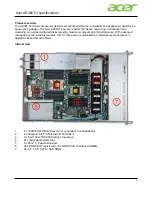
Electrostatic Discharge (ESD)
CAUTION!
ESD CAN DAMAGE DRIVES, BOARDS, AND OTHER PARTS. WE RECOMMEND THAT YOU
PERFORM ALL PROCEDURES AT AN ESD WORKSTATION. IF ONE IS NOT AVAILABLE,
PROVIDE SOME ESD PROTECTION BY WEARING AN ANTI-STATIC WRIST STRAP AT-
TACHED TO CHASSIS GROUND -- ANY UNPAINTED METAL SURFACE -- ON YOUR SERVER
WHEN HANDLING PARTS.
Always handle boards carefully. They can be extremely sensitive to ESD. Hold boards only by
their edges without any component and pin touching. After removing a board from its protective
wrapper or from the system, place the board component side up on a grounded, static free sur-
face. Use a conductive foam pad if available but not the board wrapper. Do not slide board over
any surface.
System power on/off:
To remove power from system, you must remove the system from
rack. Make sure the system is removed from the rack before opening the chassis, adding, or
removing any non hot-plug components.
Hazardous conditions, devices and cables:
Hazardous electrical conditions may be
present on power, telephone, and communication cables. Turn off the system and disconnect the
cables attached to the system before servicing it. Otherwise, personal injury or equipment dam-
age can result.
Electrostatic discharge (ESD) and ESD protection:
ESD can damage drives,
boards, and other parts. We recommend that you perform all procedures in this chapter only at
an ESD workstation. If one is not available, provide some ESD protection by wearing an antistatic
wrist strap attached to chassis ground (any unpainted metal surface on the server) when handling
parts.
ESD and handling boards:
Always handle boards carefully. They can be extremely
sensitive to electrostatic discharge (ESD). Hold boards only by their edges. After removing a
board from its protective wrapper or from the system, place the board component side up on a
grounded, static free surface. Use a conductive foam pad if available but not the board wrapper.
Do not slide board over any surface.
Installing or removing jumpers:
A jumper is a small plastic encased conductor that slips
over two jumper pins. Some jumpers have a small tab on top that can be gripped with fingertips
or with a pair of fine needle nosed pliers. If the jumpers do not have such a tab, take care when
using needle nosed pliers to remove or install a jumper; grip the narrow sides of the jumper with
the pliers, never the wide sides. Gripping the wide sides can dam-age the contacts inside the
jumper, causing intermittent problems with the function con-trolled by that jumper. Take care to
grip with, but not squeeze, the pliers or other tool used to remove a jumper, or the pins on the
board may bend or break.
Summary of Contents for G262-ZO0
Page 1: ...G262 ZO0 HPC Server 2U DP AMD OAM 4 GPU Server User Manual Rev 1 0 ...
Page 10: ... 10 This page intentionally left blank ...
Page 16: ...Hardware Installation 16 1 3 System Block Diagram ...
Page 46: ...System Hardware Installation 46 GPU 54V Power Cable GPU Riser Power Cable Bo om Board ...
Page 48: ...System Hardware Installation 48 HDD Back Panel Board NVMe Signal Cable ...
Page 49: ... 49 System Hardware Installation PCIe Signal Cable ...
Page 50: ...System Hardware Installation 50 System Power Cable Power Supply Signal Cable ...
Page 58: ...BIOS Setup 58 When Boot Mode Select is set to Legacy in the Boot Boot Mode Select section ...
Page 63: ... 53 BIOS Setup 5 2 4 1 Serial Port 1 Configuration ...
Page 71: ... 53 BIOS Setup 5 2 8 PCI Subsystem Settings ...
Page 82: ...BIOS Setup 82 5 2 17 Intel R I350 Gigabit Network Connection ...
Page 88: ...BIOS Setup 88 5 3 1 CPU Common Options ...
Page 101: ... 53 BIOS Setup 5 3 3 1 1 Enforce POR ...
Page 147: ... 53 BIOS Setup This page intentionally left blank ...






































